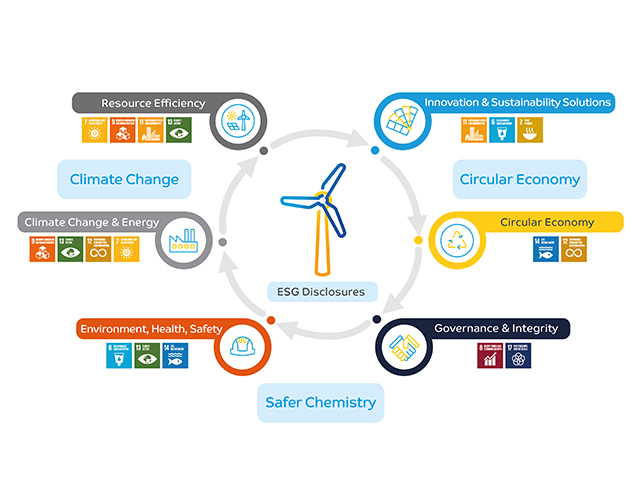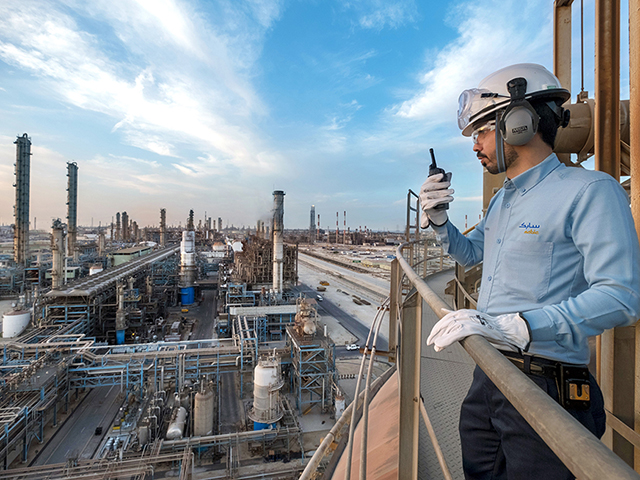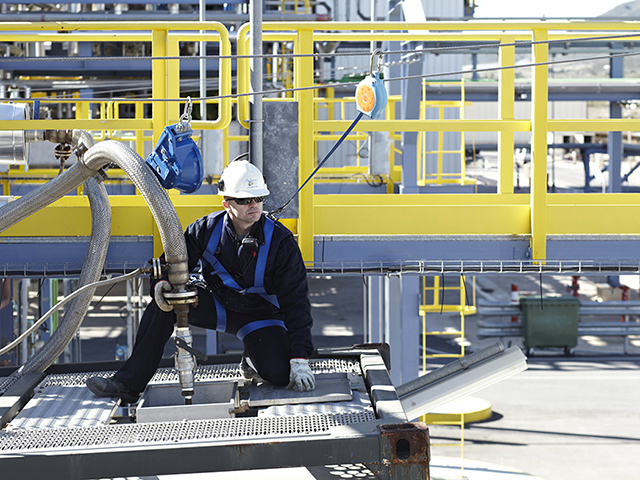Strategy
Megatrends, and increasing public awareness about environmental and social impacts, are driving companies to consider ESG risks and opportunities as integral to their core strategies. Climate change is at the top of the public agenda, and stakeholders ranging from customers, investors, and regulatory authorities demand transparency.
As a materials company, our business is energy and carbon-intensive. Avoiding engagement with stakeholders and failing to show progress on ESG issues introduces risks to our reputation and brand value, can impact capital availability and cost of capital, and can lead to reduced demand for goods and services.
But risks also imply opportunities: by delivering “first of its kind” climate change-related achievements, SABIC has significantly enhanced its reputation as a regional sustainability leader. Examples include building one of the world’s largest carbon capture and utilization (CCU) plants and carbon credit issuance under the UN Clean Development Mechanism (CDM) scheme – both of which have been widely publicized and commended by external stakeholders. The increased transparency enabled by our sustainability reporting, which has been recognized by the World Business Council for Sustainable Development, also makes us a more attractive investor and business partner.
SABIC’s sustainability strategy is guided by the need to prepare for this changing context. We are driven by four key motivating factors: addressing stakeholder needs; meeting evolving regulations; enabling responsible long-term growth; and driving a sustainable portfolio. To address these factors, we are integrating ESG principles into every function of our business, with each aspect of “ESG” playing a critical role.
Under Environment, we strive to serve as a responsible steward of nature by identifying climate risks and opportunities, exploring sustainable solutions within our portfolio, and enhancing our environmental reporting. We are committed to promoting sustainable practices and mitigating our impact on the environment.
Under Social, we recognize that SABIC is part of a larger ecosystem that includes employees, suppliers, customers, and communities. We prioritize diversity, equity, and inclusiveness, uphold human rights, engage in corporate social responsibility, and promote local content. By attracting, developing, and retaining top talent, we foster a workplace that reflects our commitment to social responsibility.
And Governance encompasses SABIC's management, controls, structures, compliance, leadership compensation, audits, and shareholder rights. We work to enhance our corporate governance standards, promote ESG matters, and invest sustainably and innovatively. We prioritize ethical business conduct, strengthen IT security, improve tax reporting, and foster ESG attributes within our supplier management. By ensuring strong governance practices, we build a foundation for sustainable growth and success.

ACTING ON OUR SUSTAINABILITY STRATEGY
Our six sustainability materiality areas – resource efficiency; climate change and energy; innovation and sustainability solutions; circular economy; governance and ethics; and EHSS – are aligned with 10 of the 17 UN Sustainable Development Goals (SDGs), addressing issues such as poverty, climate change, environmental degradation, human rights, labor, and anticorruption. We act on and operationalize our six sustainability materiality areas through four strategic domains: climate change, circular economy, safer chemistry, and ESG disclosures.
CLIMATE CHANGE
In 2021, SABIC unveiled its Carbon Neutrality Roadmap, laying out its strategy to decarbonize operations by 2050 in line with the goals of the Paris Agreement. The roadmap identifies five pathways to decarbonization―Reliability, Energy Efficiency, and Improvements; Renewable Energy; Electrification; Carbon Capture; and Green/Blue Hydrogen – and commits to reducing GHG emissions by 20% by 2030 in adherence to our carbon neutrality pledge. With our shift from intensity-based GHG emissions targets tCO2e/t products sold to absolute targets (tCO2e), our focus is on energy efficiency, renewable energy and carbon capture to meet our interim 2030 goals. Electrification and green/blue hydrogen remain part of a long-term plan to drive our progress to carbon neutrality by 2050.
We recognize that SABIC has an important role in championing the chemicals industry in Saudi Arabia to pursue strategies that fulfill Saudi Vision 2030. SABIC was represented at the COP27 climate change negotiations and was integral in doing its part for the Saudi Green Initiative. One of our most prominent efforts to advance sustainability was commencing construction, in partnership with BASF and Linde, on the world’s first large-scale electrically heated steam cracker that has the potential to reduce carbon dioxide emissions from one of the petrochemical industry’s most energy-intensive production processes by as much as 90%. Additionally, we studied the establishment of a complex in Ras Al-Khair, Saudi Arabia, that will convert 400,000 barrels of oil and liquids into petrochemicals daily as part of our effort to help the Kingdom’s program to offer large-scale cost efficiencies and open value-creation opportunities for the energy and chemical industry.
As part of our collaboration with the Circular Carbon Economy National Program (CCE-NP) launched by the Saudi Ministry of Energy, we are establishing a Carbon Capture Use and Storage (CCUS) hub in Jubail. The aim of the hub is to capture a total of 4 million metric tons of CO2 annually (with 2 million metric tons captured annually by 2030). SABIC also aims to transition to renewable energy with the ambition of facilitating an installed capacity of 4 GW by 2025 and 12 GW by 2030 in Saudi Arabia, and switching from steam-driven compressors and pumps to electric that will reduce GHG emissions. SABIC has continued to improve its reliability and energy efficiency and renewable feedstock, while commencing manufacturing blue hydrogen at Wilton Teesside.
The only way to navigate the giant paradigm shift transforming industries is to transform our business, addressing urgent global challenges by building partnerships across the industry and enforcing efficient carbon management policies.

We are committed to promoting sustainable practices and mitigating our impact on the environment.
CIRCULAR ECONOMY
To secure and maintain a leading position in advanced recycling, SABIC is committed to growing circular products that boost the circular economy, adapting existing processes to using renewable and recycled feedstock, and developing recyclable product design solutions for customers.
We are deeply committed to investment in the circular economy. The circular economy inspires us to adapt our processes to the use of renewable and recycled feedstock, and to create durable, recyclable product design solutions for our customers. Since launching the TRUCIRCLE™ initiative in 2019, we have contributed to the growth of the circular economy through various services, business models, and partnerships. In 2022, we launched a pilot project to investigate the use of blockchain technology in supporting end-to-end tracking of circular feedstock in customer products, and announced our commitment to processing from bio-based or recycled feedstock at least 1 million metric tons of our TRUCIRCLE™ products every year by 2030.
In 2022, we launched the BLUEHERO™ portfolio to enhance our investment into the circular economy, providing materials, solutions, expertise, and programs that will help accelerate the world’s energy transition to electric power in an effort to meet global goals on climate change. In 2022, BLUEHERO™ supported the automotive industry in its mission to create better, safer, and more efficient electric vehicles (EVs); the focus fell on optimizing structural battery components with unique flame-retardant materials and solution-development expertise.

SABIC is committed to ensuring that EHSS is practiced throughout the business.
SAFER CHEMISTRY
SABIC is committed to ensuring that EHSS is practiced throughout the business. Having identified an increasing need to manage chemicals safely and judiciously, SABIC is dedicated to decreasing or avoiding the use of Chemicals of Concern (CoCs) beyond market requirements and global regulations.
In 2022, SABIC placed 25 prioritized CoCs used in manufacturing products under review to identify opportunities that could be taken to decrease their use. In addition, the Safer Chemistry program team is setting formal targets to enhance transparency to develop metrics that will improve our ability to take greater action on CoCs in the years ahead. Meanwhile, the SABIC Sustainable Chemistry program followed the Circular Chemistry and Sustainable Solutions programs to fulfil the Safer Chemistry ambition. Circular Chemistry aims to develop chemicals and technologies to enhance reusing products (mechanically recycled products, certified circular products, and certified renewable products) while Sustainable Solutions develops a portfolio of chemicals with favorable sustainability features (reducing CO2 emissions, improving energy efficiency, and increasing resource efficiency). This two-pronged approach should allow us to address the issues of Safer Chemistry to phase out substances of concern and provide solutions to reduce hazards while addressing existing industry challenges. This year, our efforts marginally improved in our most recent ChemScore performance, earning a C-Grade. We have established a dialogue with ChemSec to support an enhanced SABIC score in the future.
SABIC works to comply with all applicable government regulations for chemical management, along with the EU’s Registration, Evaluation, Authorization, and Restriction (REACH) framework. Our ESG disclosures will provide transparency to external stakeholders and monitor SABIC’s Safer Chemistry performance. Our overall objective is to embed Safer Chemistry principles in every facet of SABIC’s business and product design processes.
In terms of process safety, we focused on using smart KPIs to encourage reporting risks and advocating for adequate risk responses as part of our 2025 EHSS strategy this year. SABIC adapts to improve where necessary in sustaining its journey toward Process Safety Excellence, continuing to bolster Process Safety competency across the entire organization. We maintained certification in ISO 45001:2018 for occupational health and safety, conforming with the best international EHSS standards of excellence to achieve our EHSS objectives, and meet regulatory and contractual requirements through periodic auditing.
In our bid to increase transparency, SABIC made significant progress in enabling employees and external customers to view product safety data and hazard information through its new One Safety Data Sheet (SDS) Portal launched in 2022. It improves the effectiveness of our compliance management systems and processes, and is poised to enhance our compliance position moving forward.
ESG DISCLOSURES
The publication of SABIC’s first Sustainability Report in 2011 marked our first steps in sharing our ESG journey. Although ESG factors are considered non-financial, they possess measurable financial consequences by bringing into focus hidden investment risks and value drivers. Since that milestone, we have made progress over the decade in increasingly identifying opportunities to weave ESG considerations into our business.
This year, we modified our governance approach by creating a dedicated PMO, which is governed by the ESG Steering Committee, to develop ESG processes for internal focus. This enables SABIC to execute the roadmap on critical areas that require capabilities to be built. The ESG Reporting Practitioners Group worked to create more engagement, both functionally and regionally. For the immediate short-term, it will deal with new disclosures as part of the current ESG-development state and focus on developing ESG content over the next 2–3 years. It will also provide oversight of the overall strategic transition to integrated reporting in 2023.
We have developed an internal ESG ecosystem at SABIC that encompasses various components such as drivers, a framework, foundation projects and enablement. Our ESG drivers include a range of efforts that strive to enhance the efficiency of ESG disclosures, ensure transparency and compliance; bolster our sustainable portfolio to retain our competitive-market edge; and embed sustainable investments discipline for better scrutinized decision-making. We strive to achieve all of this while maintaining cost efficiencies.
Our ESG framework at SABIC is designed as a pyramid structure. It begins with the foundation of ESG KPIs, metrics, and narratives, which are used to develop and improve systems and processes. This is followed by ESG-enabled risk management to identify ESG risks and opportunities, and integrated into the company’s strategic planning processes. Finally, the governance component represents the tip of the pyramid and thereby ensures robust ESG frameworks that guide good governance.
We have implemented several ESG foundation projects at SABIC that address every aspect of our sustainability efforts. These include product carbon footprint, sustainability assessments, biodiversity assessments, Task Force on Climate-related Financial Disclosures (TCFD) assessments, sustainable investments, risk management, monetizing ESG impacts, and EU taxonomy. Additionally, we focus on ESG enablement, which involves developing ESG frameworks and definitions, automating ESG data, ensuring ESG quality assurance, implementing ESG governance and controls, and promoting ESG culture and change management. Our approach will serve as a template for building a sustainability-focused future at SABIC that benefits all stakeholders, including shareholders, customers, investors, and others.
Along with aligning our strategies with the UN SDGs, we are also working with the World Economic Forum (WEF) framework and are active participants of the WEF ESG Practitioners group. We are also working to further improve the quality of our reporting with reference to or consultations with various bodies and agencies such as the Global Reporting Initiative (GRI); UN Global Impact; the World Business Council for Sustainable Development (where we joined the CFO network this year); EcoVadis; Ethisphere Institute; and TCFD. We also contributed to the open consultations on the International Financial Reporting Standards Foundation’s creation of the International Sustainability Standards Board (ISSB), providing support for its formation and calling for fair representation of developing countries. These frameworks and guides provide a standardized outline map that will be valuable in our ESG journey.
SABIC was recently awarded a Gold EcoVadis Medal, receiving a score of 72 points out of 100. EcoVadis is a worldwide ratings agency that provides assessment and feedback about the sustainability and corporate social responsibility performance of evaluated companies. Many of our customers, in fact, use EcoVadis’s assessments to qualify their suppliers. Our score places us in the top 5% of companies assessed by EcoVadis in the “manufacture of basic chemicals, fertilizers and nitrogen compounds, plastics and synthetic rubber” industrial category.

We are building a sustainability-focused future at SABIC that benefits all stakeholders, including shareholders, customers and investors.
